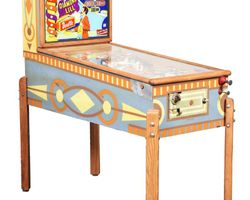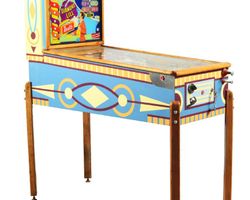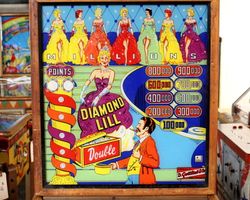Diamond Lill

Average Prices: USD $200 to $600
Produced: December, 1954
Production Run: 700 units
Machine Type: Electro-mechanical
Players: 1
Design by: Wayne Neyens
Art by: Roy Parker
"Diamond Lill," a pinball machine from D. Gottlieb & Co., emerged in December of 1954, a product of the electro-mechanical (EM) era. As Model 88, this one-player game represented a distinct chapter in Gottlieb's extensive history, particularly notable for its limited production run of 700 units. This relatively low number has contributed significantly to its scarcity today, making it a coveted item for collectors.
The creative force behind "Diamond Lill" was primarily Wayne Neyens, who is credited with the machine's design, core concept, animation, and mechanical engineering. This comprehensive involvement ensured a cohesive vision from start to finish. The artistic flair was provided by Roy Parker, whose work on the backglass and playfield contributed to the machine's visual identity. "Diamond Lill" falls into the "woodrail" category, characterized by the wooden side rails of its cabinet, a common design element during the 1950s. This construction adds to its vintage appeal and distinct feel compared to later solid-state machines.
Signature Features and Design
"Diamond Lill" captivates with a design that marries visual spectacle with engaging mechanics, characteristic of D. Gottlieb & Co.'s EM offerings. A standout element is the "action ring," an inner circular track positioned around the cluster of pop bumpers. This feature is not merely decorative; when illuminated, especially in subdued lighting, it creates a visual effect that mesmerizes players. This dynamic lighting, alongside the overall vibrant artwork by Roy Parker, contributes to the machine's reputation as a "looker," a term often used by enthusiasts to describe visually appealing games.
The horseshoe lane is another prominent design feature, celebrated for its "dazzling and wonderful colors" during gameplay. This integrated light show highlights successful shots and guides the player's eye, enhancing the sense of accomplishment. While the machine is broadly praised for its beauty, some observers have noted specific details in the backglass artwork, particularly the depiction of the main female character, suggesting a deviation from what might be considered conventional beauty standards of the era by some collectors. Despite these individual preferences, the machine's aesthetic package, combining intricate lighting effects with expressive art, firmly establishes its unique visual identity and contributes to an immersive pinball experience.
Playfield and Mechanics
The playfield layout of "Diamond Lill" is thoughtfully designed, offering a surprising depth of engagement for an EM machine from its period. The lower playfield features two flippers, positioned in an inverted or reverse configuration, which sets the stage for a unique gameplay dynamic. Above the flippers, the main area is dominated by four pop bumpers and three passive bumpers, strategically placed to create a lively and unpredictable ball trajectory. Two kick-out holes provide distinct targets, rewarding precise shots with ball returns to different areas of the playfield or points. Additionally, two rollunders guide the ball beneath plastic features, and a prominent horseshoe lane loops around the upper playfield.
The design philosophy behind this layout emphasizes continuous flow and strategic nudging. Shots directed around the loop encircling the pop bumper ring offer a satisfying experience as the ball travels back towards the top of the playfield, creating opportunities for sustained play. The artwork, a testament to Roy Parker's skill, infuses the playfield with a thematic coherence that complements the mechanical elements. Lighting plays a pivotal role; beyond the horseshoe lane's light show, the center plastics illuminate in sequence, followed by the resetting of the bumpers, providing satisfying visual feedback and contributing to the machine's overall aesthetic and interactive appeal. This combination of well-placed targets, dynamic lighting, and a flow-oriented layout ensures that "Diamond Lill" offers a captivating and responsive mechanical experience.
Gameplay Dynamics
The gameplay of "Diamond Lill" demands both precision and active player interaction, firmly establishing it as a "true nudger's table." Players must constantly engage with the machine, making every contact count to keep the ball in play and advance objectives. The scoring system and progression are designed to be challenging, particularly when aiming for replays. There are four distinct pathways to earn replays: accumulating a significant score (big points), reaching a smaller score threshold, hitting specific hole specials, and activating a random special positioned between the flippers. The simple task of completing the 1-10 number sequence, often a side objective in many EM games, proves surprisingly difficult on "Diamond Lill," adding another layer of challenge.
A defining characteristic of "Diamond Lill's" gameplay is its inverted flipper setup. While not a universally preferred flipper configuration across all pinball machines, on "Diamond Lill," these flippers are not only functional but integral to the machine's strategic depth. They require players to pay close attention, often re-training their muscle memory to achieve precise shots. This setup proves particularly effective for navigating the center circular lanes and is well-suited for directing the ball into the side kick-out holes. To ensure the ball consistently reaches the upper playfield, the flippers must be well-maintained and possess sufficient power. The interaction between the inverted flippers and the prominent center drain, combined with the game's emphasis on nudging, means the ball can easily find its way to the center with even a slight nudge off the playfield rubbers, necessitating a high level of player skill and control.
Reception and Legacy
"Diamond Lill" has garnered a largely positive reception within the pinball community, often celebrated as a fantastic and well-regarded game, particularly for its era. It is frequently described as both a "looker and a player," signifying its dual appeal in aesthetics and gameplay. Many enthusiasts consider it capable of standing alongside other highly regarded D. Gottlieb & Co. machines from its time.
Its strengths include the uniquely engaging gameplay fostered by the inverted flippers, which, despite initial unfamiliarity, are seen to integrate seamlessly into the machine's design. The vibrant light show, particularly around the horseshoe lane and the central action ring, is consistently highlighted as a major draw, contributing significantly to the machine's visual appeal and player satisfaction. The demanding requirement for nudging is viewed as a positive attribute, transforming the game into a skill-intensive experience that rewards player mastery.
However, "Diamond Lill" also faces certain considerations. Its limited production run of 700 units makes it exceptionally difficult to acquire, with copies often residing exclusively in private collections. This scarcity can be a source of frustration for collectors seeking to experience or own one. Additionally, as noted earlier, opinions on the specific artistic details of the backglass, particularly the main character, vary among collectors. Despite these points, its overall reputation is strong. "Diamond Lill" remains a significant electro-mechanical pinball machine, showcasing Wayne Neyens' design prowess and Roy Parker's artistic contribution. Its unique flipper configuration and emphasis on player skill have cemented its place as a memorable and sought-after piece of pinball history, influencing how players approach strategy and control on EM games.
Sponsored Links
 Ebay Listings
Ebay Listings
 Auction Results
Auction Results
| Cost | Location | Date |
|---|---|---|
| USD $2,450 |  Ohio, United States Ohio, United States |
12 September, 2024 |
| USD $800 |  Nevada, United States Nevada, United States |
20 May, 2018 |
| USD $850 |  Nevada, United States Nevada, United States |
27 January, 2018 |
| USD $225 |  United States United States |
10 December, 2004 |
| USD $450 |  United States United States |
03 May, 2002 |
| USD $165 |  United States United States |
04 January, 2002 |
| USD $225 |  United States United States |
19 October, 2001 |
| USD $175 |  United States United States |
23 April, 1999 |


Private Policy · Search Website · Contact Us
As an eBay Partner, we may earn a commission from qualifying purchases made through links on this site, at no additional cost to you.
All trademarks and copyrighted materials remain property of their respective owners. All other content copyright 2007 - 2025 Pinpedia.



